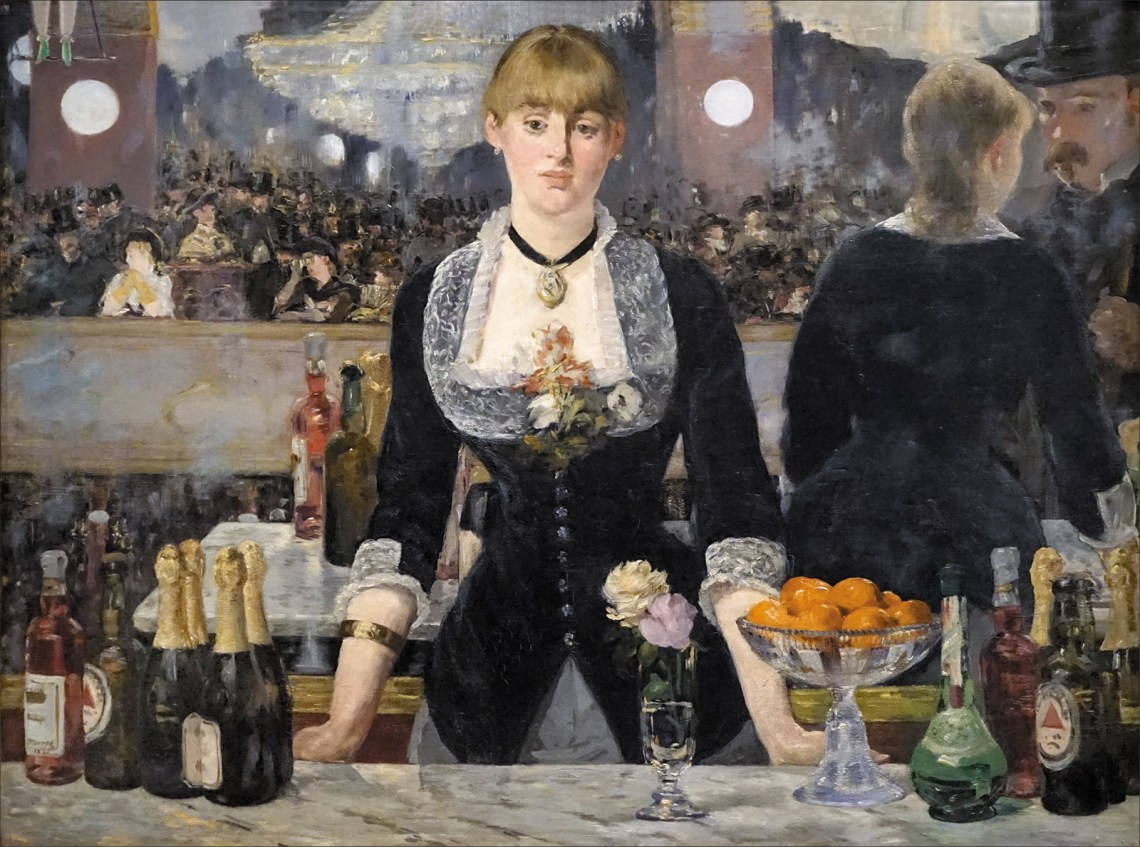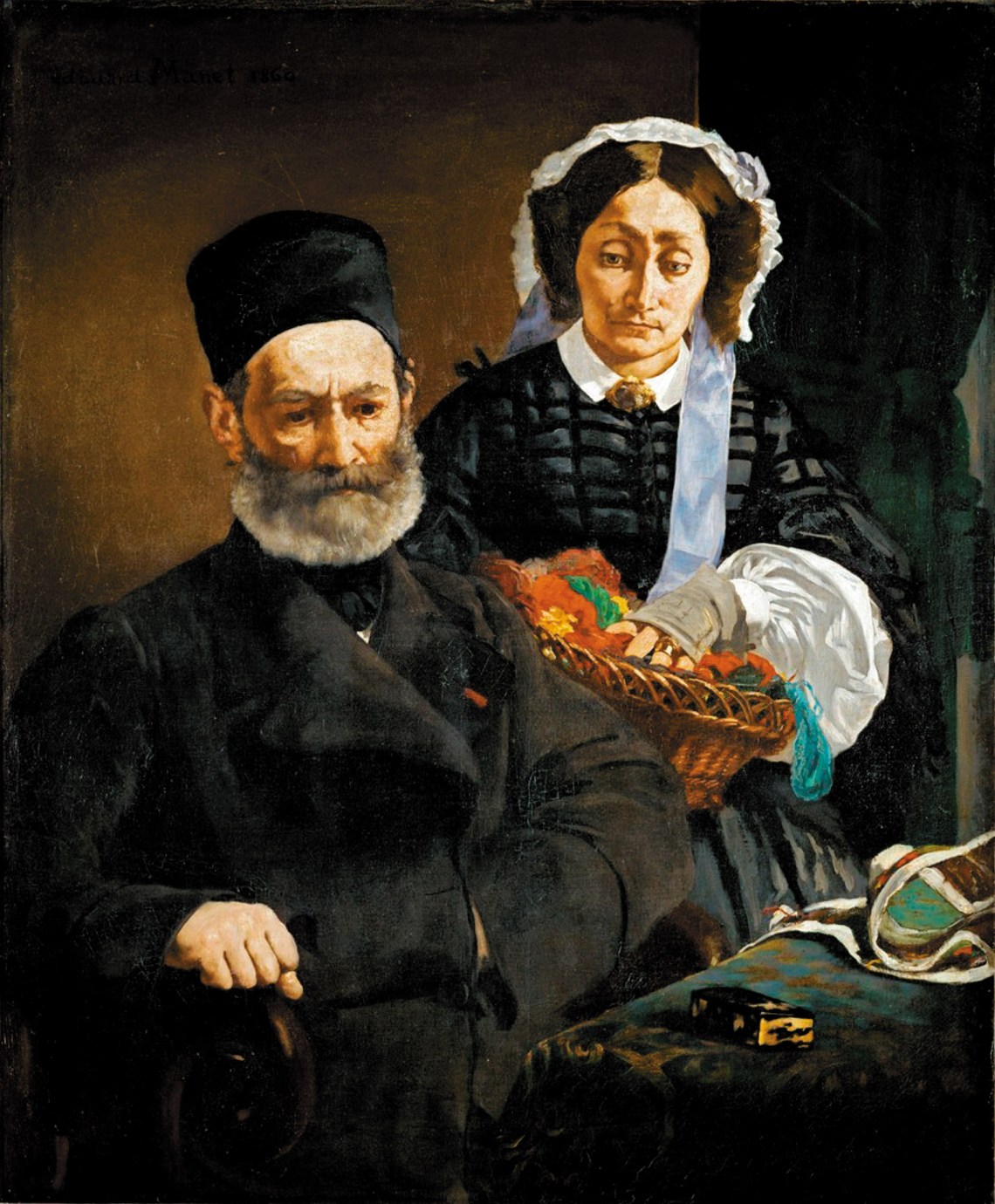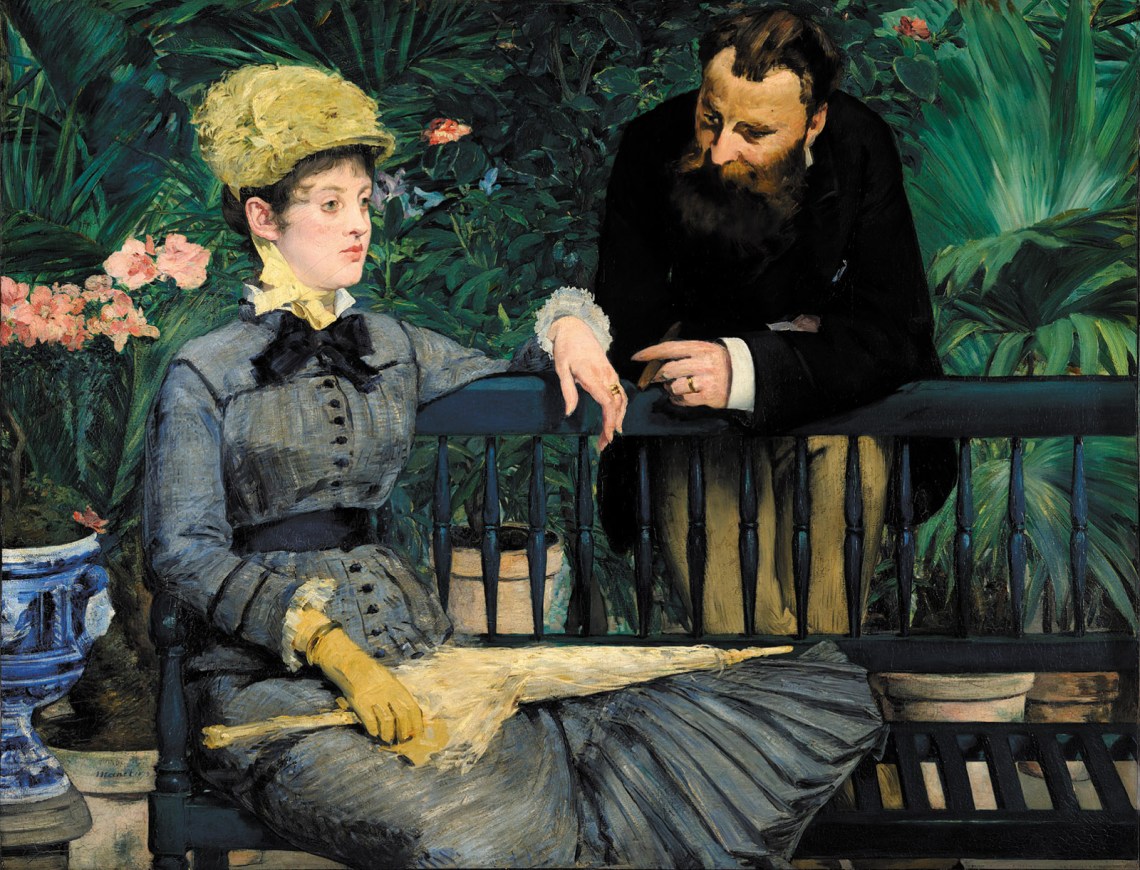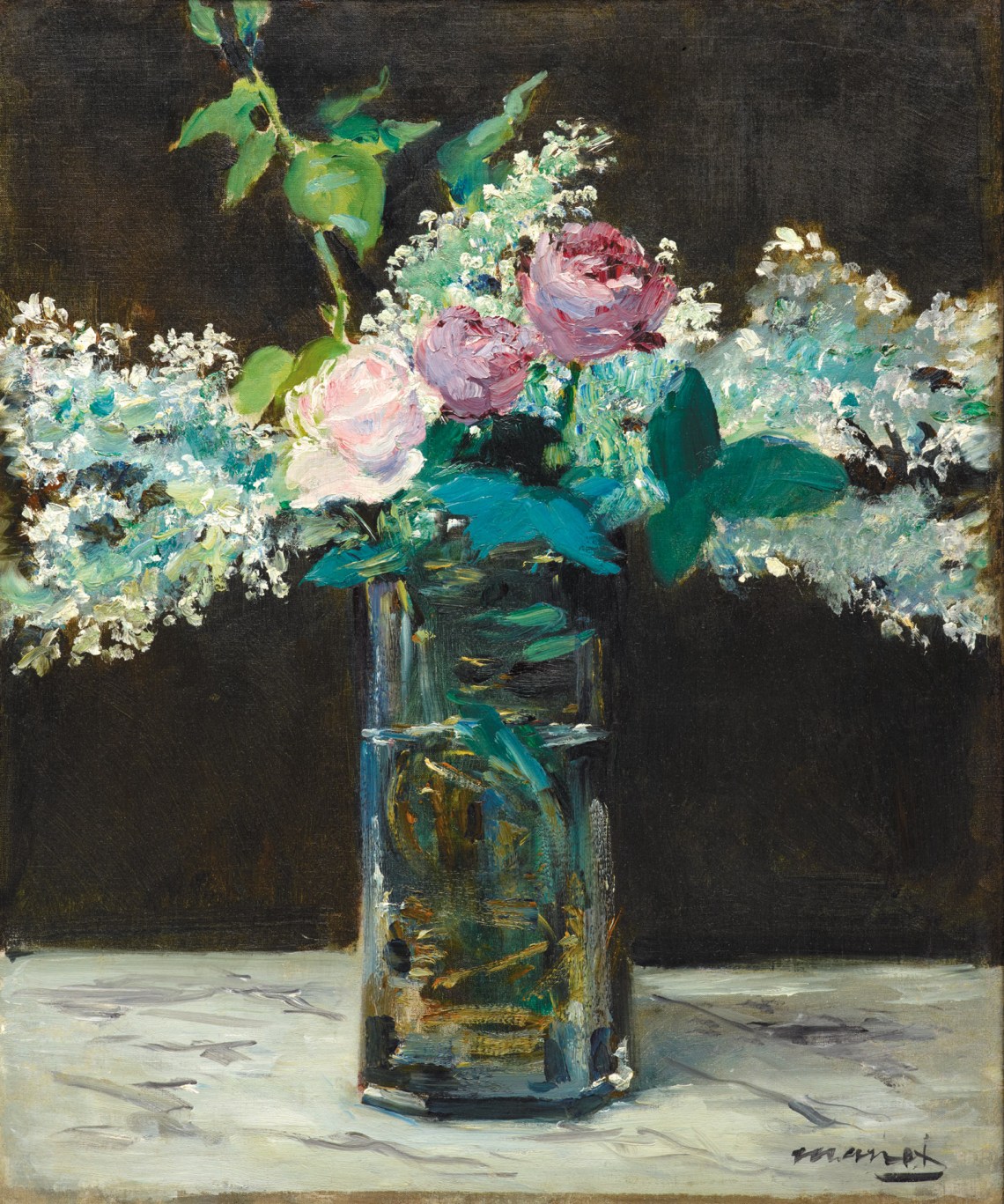During a visit to the eighty-five-year-old Claude Monet in the summer of 1926, Florence Gimpel, the wife of the Parisian art dealer René Gimpel, asked her host if he had known Édouard Manet. “Yes, he was a great friend, a great friend,” was the response. Monet told Gimpel that on April 29, 1883, he had received a telegram from Manet’s brother Gustave informing him that the painter was dying:
I saw him two days before his death. He had phlebitis and it had been necessary to cut off his leg, but he hadn’t been told. When I approached his bed, he said: “Now watch out for my leg. They wanted to cut it off, but I said they mustn’t and I’ve kept it. Watch out.”1
Six years earlier Monet had recounted more or less the same story to the art critic and anarchist impresario Félix Fénéon. In that version, Manet took fright when Monet started to lay his hat on the bed: “Watch out! You’ll hurt my foot!”2
Manet died, aged fifty-one, on the evening of April 30, 1883, ten days after his left leg had been amputated to stem the gangrene with which it was infected. Contrary to his later stories, Monet did not visit him on his deathbed, but he did receive a telegram from Gustave Manet on May 1 requesting that he come to Paris immediately to serve as one of the six pallbearers. Monet was in the process of moving into his house in Giverny with Alice Hoschedé, the estranged wife of his (and Manet’s) patron, Ernest Hoschedé. He had to borrow money from his dealer, Paul Durand-Ruel, for the train journey back to Paris, and also had to ask him to cover the cost of his mourning suit. Manet was buried at the Cimetière de Passy on May 3, and his funeral was attended by as many as fifteen hundred people, including the Impressionists Pierre-Auguste Renoir, Edgar Degas, Alfred Sisley, Camille Pissarro, and Berthe Morisot.
During the last months of Manet’s life, the press had regularly reported on the state of his health. In some accounts, he was suffering from “a malady of the spinal cord,” in others, “phlebitis.” On the morning of April 20, 1883, Paul Jules Tillaux, professor of surgery at the hôpital Beaujon, operated on Manet in the salon of the family apartment at 39, rue de Saint-Pétersbourg. He initially removed Manet’s gangrenous left foot, and in a second operation amputated the leg just below the knee. Sedated by chloroform, Manet felt no pain and may have been unaware of the loss of his limb.
The critic Philippe Burty—a good friend of the artist and another of his pallbearers—noted in his obituary that Manet died from the same neurological disorder as his father had. The term “syphilis” was never mentioned, but this “tainted heredity” was widely known.3 Auguste Manet, a respected magistrate and head of personnel at the Ministry of Justice, was stricken by paralysis in 1857 and ceased reporting to his chambers at the end of that year. He took official retirement in February 1859 and in his last years suffered from general paresis—inflammation of the brain that caused progressive dementia and paralysis, which was a common symptom of tertiary syphilis. In 1860 Manet painted a dignified double portrait of his infirm father watched over by his attentive wife, Eugénie-Désirée, which he exhibited at the Salon of 1861 (see illustration on right). It was included in the exhibition “Portraits du siècle (1783–1883)” at the École nationale supérieure des Beaux-Arts, which opened five days before Manet died. Approval of this loan must have been one of the last decisions that he was able to make.
Manet first felt the consequences of his untreated tertiary syphilis in 1878–1879, when he apparently experienced severe shooting pains in his leg. Chronic pain became an almost permanent condition after 1879. His gait was unsteady, and he had difficulty walking and standing upright for any length of time. Manet was suffering from tabes dorsalis, the degeneration of nerves in the dorsal column of his spinal cord, a primary symptom of which was locomotor ataxia. Known colloquially by his contemporaries as l’ataxie, this neurological disorder made it increasingly difficult to coordinate the muscle groups used in walking. Unlike his father, Manet seems to have been spared the debilitating effects of general paresis, and he did not experience visual impairment or dementia in his final years.
Before he turned forty-eight, Manet began to treat his illness through hydropathy, drugs, and rest cures in Versailles and the spa town of Bellevue, some eight miles southwest of Paris. He was surrounded by a phalanx of doctors and what today might be called practitioners of alternative medicine. He took mercury, chloral, bromide, morphine, and laudanum Sydenham. (Penicillin, discovered in 1928, was used as a cure for syphilis only after 1943.) Manet became addicted to ergot, a derivative of a rye fungus, which had been prescribed as a vasoconstrictor. For Degas, this was nothing more than “a midwife’s remedy.” On March 29, 1883, Pissarro wrote to his son Lucien:
Advertisement
Our poor friend Manet is at death’s door. He has been absolutely poisoned by allopathic medicine, and has gangrene in his leg caused by having taken shockingly large doses of rye ergot. We lose a great artist and a charming man.
Under the primary care of his family physician, François Siredey—a renowned gynecologist, chief physician at the hôpital Lariboisière, and the owner of his beautiful early still life Fruits on the Table (1864)—Manet likely took his first thermal and hydropathic cures in 1879–1880 at clinics in Paris and Auteuil overseen by Joseph Marie Alfred Beni-Barde. The établissement hydrothérapique at 63, rue de Miromesnil—a few streets away from Manet’s apartment and studio—had been founded only a few years earlier, in 1876. The clinic at Auteuil, which dated to the 1820s, was housed in an imposing set of buildings and grounds. On offer at both clinics were ice-cold showers, hydroelectric baths—full immersion in tubs with electrodes—and massages (sessions might last for five hours).
Manet was tended by Beni-Barde’s disciple Dr. Paul Materne, renowned for the energy with which he administered his showers. His sympathetic pastel portrait of Materne, done around 1880, draws attention to his sitter’s thick dark beard, which would routinely become drenched during the course of treatment.4 Manet referred affectionately to the nurses at these clinics as “les Beni-Bardeuses,” confiding to his childhood friend and first biographer, Antonin Proust (no relation to the writer), “When they see me walking down the steps of the swimming pool with a smile on my face, then I know I will be out of danger and it won’t be a long time coming.” In August 1882, Manet introduced Émile Zola, who wanted details of hydropathic treatment, to Beni-Barde’s Parisian clinic, which the two men visited together. Not content with simply having a shower, Zola spent the afternoon taking notes.
During the spring of 1880 Manet’s condition deteriorated. He confided to both Stéphane Mallarmé and Alexandrine Zola that he had been told to avoid climbing stairs whenever possible. Between June and October he followed a course of therapeutic showers and massages at the celebrated établissement hydrothérapique that had been founded in 1846 in Bellevue. (Beni-Barde had worked there in the early 1860s.) Manet was accompanied by his wife and mother, and a small group of paintings and drawings he did that summer shows them sitting in the garden of the house they rented.
“The showers are simply torture for me,” he wrote to the actress Méry Laurent, to whom he had been introduced by Mallarmé four years earlier. “It’s much less comfortable than at Beni-Barde’s establishment.” Despite his disappointment with the clinic’s personnel, Manet seems to have followed the regime at Bellevue diligently and resisted the desire to return to Paris. In early August he arranged for Chez le Père Lathuille—his painting of an ardent young man enraptured with his somewhat older dining companion on the terrace of a well-known Parisian restaurant, shown a few months earlier at the Salon of 1880—to be sent to an exhibition in Ghent. He did not expect that it would be any better received there than it had been in Paris, he informed the Belgian lawyer Eugène Maus, but was hopeful that he might be able to sell it since “this course of treatment is expensive.”
Manet did not return to Bellevue the following summer, but instead rented a villa in Versailles in July 1881, where he planned to take walks in Le Nôtre’s gardens and use them as the setting for his paintings. (In the end, he was not strong enough to do so.) In the summer of 1882 he moved his household to another rented house in the village of Rueil, west of Paris. He made ravishing, sun-drenched views of the gardens of both villas, painted in an exuberant Impressionist manner but notable for their stillness and emptiness; they are bereft of any human presence. Returning to Paris a little earlier than expected, on September 30, 1882, Manet drew up his last will and testament, leaving everything to his wife, Suzanne, and instructing her to ensure that the entire inheritance would eventually pass to her son, Léon Leenhoff, “who has attended me with the greatest care.”5
Certain of Manet’s colleagues were well aware of his condition. Monet noted in December 1880 how pleased he had been to see Manet looking so healthy and working away on a “sensational” submission for the next Salon. Manet regularly discussed his health with his sister-in-law Berthe Morisot and intimates such as Mallarmé and Proust. In December 1881 he discreetly alluded to his disease in a letter to the critic Ernest Chesneau: “And you, my dear Chesneau, how are you feeling? I was counting all the more on news of your health, since mine is not so wonderful at the moment.” In a condolence letter to Suzanne in May 1883, Chesneau noted that he and her husband “were of exactly the same age and afflicted by very similar diseases.”
Advertisement
Even though walking had become more and more difficult for this inveterate boulevardier, in the spring of 1880 Manet was insulted to have been offered a seat at the premises of the fashionable Parisian milliner Madame Virot, where he had gone to choose a hat for a model. “I’ve no need of a chair,” he grumbled. “I’m not disabled.” Once his good mood had been restored, he could laugh at her gaffe: “To think she made me look like a cripple in front of all those women.” On July 10, 1882, Manet responded to a brief article on the front page of L’Événement alluding to his ill health. He was not at all unwell, he reassured readers, but had simply twisted his ankle before leaving Paris for the summer.
By this point, Manet was no longer able to paint standing up for any length of time. He seized upon hopeful diagnoses and various treatments—to Degas’s dismay—and his family and close friends monitored his health carefully. There is no detailed contemporary record of the effects of his illness—and certainly no evidence of any weakness or diminishment in his canvases of these last years—but some sense of the debilitating conditions Manet must have experienced can be inferred from the “pain diary” of the naturalist writer Alphonse Daudet, who had been infected with syphilis at seventeen and whose symptoms began to manifest themselves in the late 1880s. Often in excruciating pain, especially in his foot and heel, Daudet noted the onset of hand tremors, photosensitivity, and the disturbance of his gait: “Can’t go down a staircase if there isn’t a handrail; can’t walk across a waxed floor.” He left accounts of visits to spas, thermal baths, and hydropathic clinics, including the terrifying experience of being suspended from his jaw to stretch his spine, a treatment known as Seyre’s apparatus that had been imported from Russia by the celebrated neurologist Jean-Martin Charcot. “Even the simplest and most natural of actions requires an effort of will,” Daudet noted. “Walking, standing up, sitting down, staying upright, taking your hat off or putting it back on.”
When Manet, who had been submitting paintings to the Salon since 1861, was finally awarded a second-class medal at the close of the Salon of 1881—enabling him at last to bypass the jury in the future—he insisted upon thanking in person each of the seventeen jurors who had voted for him. These visits must have been a tremendous ordeal.
Daudet described himself as “the one-man band of pain.” Manet was not given to such introspection, but the consequences of his tertiary syphilis are relevant to a fuller understanding of the achievement of his last years. (It makes little sense to speak of Manet’s “late style.”) This was the background for “Manet and Modern Beauty: The Artist’s Last Years,” a fine exhibition on view last year at the Art Institute of Chicago and the J. Paul Getty Museum that brought together around ninety works made between 1878 and 1883, including a selection of rarely exhibited illustrated letters.
The project was inspired by the Getty’s acquisition in November 2014 of Manet’s Jeanne (Spring), which the artist had exhibited at the Salon of 1882 along with his final masterpiece, A Bar at the Folies-Bergère.6 Modeled by a sixteen-year-old aspiring actress named Anne Darlaud, who went by the stage name Jane Demarsy, this celebration of Parisian fashion and femininity had been well received at the Salon. One reviewer assumed that the young woman was promenading with her parasol in the Bois de Boulogne, and Jeanne (Spring) elicited considerably more enthusiasm than A Bar at the Folies-Bergère. Commissioned by Proust as part of a series of the Four Seasons—of which only one other painting, Autumn (Méry Laurent), was started before Manet died—Jeanne (Spring) was unabashedly Impressionist in handling and palette, though it shared affinities with the work of less avant-garde painters such as James Tissot and Alfred Stevens, the latter another pallbearer at Manet’s funeral.7
Exhibitions, unlike books and catalogs, cannot always tell the story they set out to tell. Certain works may be unable to travel for reasons of conservation or the restrictions of their bequest, or they may simply be unavailable, despite years of preparation and negotiations for loans. In “Manet and Modern Beauty,” the absence of ambitious Salon figure paintings such as Chez le Père Lathuille and A Bar at the Folies-Bergère meant that attention was given to Manet’s more intimate works: single-figure modern female subjects en plein air, pastel portraits, still lifes, decorative panels, and watercolors. The exhibition discreetly associated Manet’s failing health with this more “feminized” production, but the implication that he may have been charting an alternate course in his final years failed to recognize the urgency with which Manet continued to present himself as a public artist who sought official commissions and recognition at the Salon, despite the indifference of the government and the continuing hostility of the mainstream critics, who derided him as the master of the tache colorante—patches of color.
After President Patrice de MacMahon’s conservative government collapsed in January 1879, Manet—a radical republican and friend of Léon Gambetta and Georges Clemenceau—had high hopes that the new government of Jules Grévy would be more favorable to him. Toward the end of 1878, his efforts at securing a commission to decorate the municipal council chamber in Paris’s recently reconstructed Hôtel de Ville had come to nothing. Manet had asked Proust to introduce him to the minister of fine arts, Agénor Bardoux, who refused to see him, and had also approached the architect Théodore Ballu, who received him “like a dog that would dare lift its leg against the wall of a public building.” In April 1879 Manet approached the progressive art critic Jules-Antoine Castagnary, recently appointed head of the Municipal Council of Paris. He proposed to paint a ceiling with “all the men of our day who have contributed or are contributing to civic life,” as well as murals inspired by Zola’s novels, showing “Paris markets, Paris railways, the Paris port, the underground of Paris, Paris races and gardens.” Castagnary seems not to have responded.
Two months later, in June 1879, Manet approached Edmond Turquet, undersecretary of state for fine arts, to ask that the government purchase one of his Salon paintings for a municipal collection. (Turquet demurred.) In October 1881 Manet received authorization from the Compagnie des chemins de fer de l’Ouest to visit the Batignolles railway depot to make studies of a driver and a stoker at work, in preparation for a painting for the Salon.8 These unlikely subjects for unlikely patrons seem completely at odds with Manet’s gifts as a detached, and at times aloof, observer of patrician urban culture. But such efforts were entirely consistent with his practice of sending two paintings to the Salon every year—modern life subjects and portraits—calculated, in their scale and stark frontality, to command attention on the densely hung walls of the Palais de l’Industrie.
The calendar of the annual Salon (which opened on May 1), with the preparation of submissions during the autumn and winter for a spring deadline followed by the jury’s review, dominated the schedule and rhythms of Manet’s production until the very last months of his life. In the winter of 1882–1883, he was at work on two single-figure paintings for the Salon of 1883, neither of which was brought to completion. He made three versions of Young Woman in Riding Costume (Amazone), modeled by the daughter of a bookseller—the full length of which he slashed in frustration with his amassette (a palette knife used to prepare pigments). For his second Salon submission, The Bugler, abandoned in February 1883, Manet used as a model a former infantry officer who had been recommended by his friend the military painter Henri Louis Dupray.
Manet’s conformity with the strategies of an official painter—he had resolutely refused to participate in any of the Impressionist exhibitions, despite his admiration for the younger painters and their work—in no way undermined his disruptive aesthetic, with its coloristic modeling, systematic suppression of half-tones, and rejection of traditional chiaroscuro. In the 1870s and early 1880s Manet’s ever-heightened tonalities and more insistent brushwork—inspired by Monet and Renoir—were particularly jarring in the public arena of the Salon.
Seeing In the Conservatory—his submission to the Salon of 1879, on which he may have labored for two years—at the Art Institute of Chicago, it was not difficult to understand his critics’ bewilderment and discomfort. In its depiction of this subject with a fairly standard erotic subtext, Manet’s dazzling treatment of an encounter between an impeccably attired bourgeois couple in an indoor garden remains disturbing and transgressive. For all the painting’s luminosity, the figures’ expressions are unreadable, their body language indecipherable. Why is one of Madame Guillemet’s hands ungloved, and what is the significance of the ring on her middle finger? Why has Manet allowed her suitor’s cigar to go out? The setting is lush, yet claustrophobic; the mood expectant, but not without anxiety. The couple’s hands do not quite touch; the woman’s wide-eyed gaze and her companion’s furtive mien avoid each other and offer no resolution.9 Here was the enduring legacy of Manet’s “pantheism”: a manner of composing that, as the critic Théophile Thoré had written of Olympia in 1865, did not “value a head more highly than a slipper, and that sometimes assigns more importance to a bunch of flowers than to the face of a woman.”
In the four years that followed, Manet did not deviate from his ambition to create an enduring body of modern subjects in “a plein air illumination that could be elaborated and perfected in the studio.”10 Having moved in April 1879 to a large, light-filled studio at 77, rue d’Amsterdam, his working method until his death remained essentially unchanged. He required the presence of the model and the sitters of his portraits for multiple sessions; he reworked his canvases incessantly and might start over any number of times. (Proust recalled that seven or eight full-length canvases were used before Manet was satisfied with his portrait.) A large number of paintings remained unfinished, and several artists who visited Manet in his last years were astounded to see so many of his celebrated earlier pictures still hanging in the studio (since none of them had been sold).
With the onset of the symptoms of his tertiary syphilis, a significant change may be said to have taken place in Manet’s creative process. For an artist who had never left his apartment or studio without a pencil and sketchbook in his pocket in which to record ideas and motifs for future compositions, Manet’s physical impairment severely curtailed this method of working and might have presented insuperable challenges. As he became less mobile, he remained more and more confined to his studio, where he was often obliged to paint sitting down. His good friend and executor, the collector and art historian Théodore Duret, recalled that in his final years Manet was “practically nailed to his chair.”
Julian Barnes has observed of novelists that “pain is normally the enemy of the descriptive powers.” While the same might be said of painters, the profusion of pastels, illustrated letters, and modestly scaled still lifes shown in “Manet and Modern Beauty” poignantly demonstrated the opposite: the artist’s determination to keep working, and at the highest level. The next-to-last gallery at the Art Institute of Chicago was dedicated to a moving series of predominantly floral still lifes, modest in scale, set against gray or black backgrounds, many of which were signed (hence finished), and for which there was an avid demand from Manet’s patrons.
Despite the virtuosity and nonchalance of his handling, Manet lovingly portrayed the etched decorations in the vases—dragon motifs and parasol-carrying geishas can be discerned in some, if one looks closely—and his command is unfaltering. Among the greatest of these still lifes, Vase of White Lilacs and Roses was likely one of the last paintings Manet completed (see illustration on right). In the catalog of his posthumous exhibition, held in January 1884, eight months after his death, this painting was assigned the date February 28, 1883. Against a black background, sprigs of lilac create a canopy for three small roses, purplish in hue, clustered together in the center of the composition. Like seraphs’ wings, these white flowers fan out beyond the edges of the canvas in a silent gesture of benediction. The signature at lower right is emphatic, the last three letters of Manet’s name underlined with expressive finality.11
Appropriately enough, however, Manet’s final masterpiece was a figure painting for the Salon: A Bar at the Folies-Bergère, executed during the winter of 1881–1882, a work that is “grand, quiet and complete” (see illustration at top).12 Manet invited Suzon, the “bartender, with bangs” at the notorious café-concert, to model for him in his studio. He had also found a marble countertop—“un buffet de restaurant”—upon which to set the bottles of champagne and liqueurs, and two, possibly three, bottles of English Bass beer. By now it would have required considerable effort for Manet to climb the stairs to the second-floor balcony at the Folies-Bergère, where this bar was located, but he achieves a powerful sense of genius loci nonetheless.
Manet might be said literally to have restaged café culture in his studio. He would receive so many friends and visitors by the end of the day that a waiter was hired to serve drinks. The young painter Pierre-Georges Jeanniot recalled being welcomed by Manet while he worked on this painting: “It’s annoying, pardon me, but I’m obliged to remain seated because my foot hurts.” The celebrated histologist Dr. Albert Robin watched while Manet put the finishing touches to the gold paper on the champagne bottles. (His motor skills and hand-eye coordination remained unimpaired, as demonstrated by the exquisite group of late still lifes and flower paintings in the exhibition.)
In A Bar at the Folies-Bergère Manet portrays the barmaid with sympathy and dignity, and without the slightest insinuation of the immorality customarily assigned to her profession. She appears neither particularly melancholic nor “confined by her alienation,”13 but is presented as a self-possessed young woman with ruddy cheeks, a well-tailored ensemble, and a spry corsage. And she meets our (male) gaze with patience, forbearance, and even a hint of boredom. Concision is the supreme aspiration of the artist, Manet informed Jeanniot, and painting should never be a chore: “Pas de pensum! Ah non, pas de pensum!”
-
1
René Gimpel, Diary of an Art Dealer, 1918–1939, translated by John Rosenberg (Farrar, Straus and Giroux, 1987), p. 314. The Gimpels came to see Monet at Giverny on July 17, 1926; they had been regularly acquiring paintings from him there for a decade. ↩
-
2
Fénéon is currently the subject of a riveting exhibition at New York’s Museum of Modern Art, “Félix Fénéon: The Anarchist and the Avant-Garde—From Signac to Matisse and Beyond,” through January 2, 2021; see the review in these pages by Jed Perl, May 14, 2020. ↩
-
3
Susan Sontag, Illness as Metaphor (Farrar, Straus and Giroux, 1978), p. 59. ↩
-
4
For Materne’s obituary, see Le Gaulois (April 7, 1894), where he was described as “the alter ego of doctor Beni-Barde,” and “well-known by Parisians as someone who had devoted himself to hydrotherapy for the past twenty years.” Ernest Coquelin noted that Dr. Materne “douche lui-même” with great virtuosity, and that his beard “was very long and recalled that of a sapper’s.” See Pirouettes (Paris, 1888), p. 279. ↩
-
5
Léon’s paternity remains a subject of speculation. Until old age, he referred to Manet as his “godfather,” but in Manet’s circle had been introduced as his “brother-in-law.” Recent scholarship suggests that Auguste Manet was Léon’s actual father, and that French law prevented him from legitimizing Léon because he was the result of an adulterous union. See Nancy Locke, Manet and the Family Romance (Princeton University Press, 2003), pp. 115–117. ↩
-
6
Jeanne (Spring) was acquired for $65,125,000 at Christie’s, New York, on November 5, 2014, and installed at the museum by Thanksgiving. Forbes ran the headline, “The Kendall Jenner of the Belle Epoque Goes on View at the Getty.” ↩
-
7
See Scott Allan’s fine discussion in the exhibition catalog, “Faux Frère: Manet and the Salon, 1879–82,” pp. 33–36, 310–312. ↩
-
8
See Denis Rouart and Daniel Wildenstein, Manet, Catalogue raisonné (Paris: Fondation Wildenstein, 1975), volume 1, p. 23. As he wrote to Eva Gonzales on September 23, “I hope that the month of October will be fine enough for me to begin something for the next exhibition.” Nothing came of the railway project. ↩
-
9
See Helen Burnham, “‘The Type of an Era’: Manet and the Parisienne,” and Emily A. Beeny in the exhibition catalog, pp. 43–47, 275–277. Leah Lehmbeck was the first to identify the woman, formerly thought to be American-born, as the aristocratic Jeanne Julie Charlotte Besnier de la Pontonerie (1850–1913), who married Jules Guillemet (1843–?) in 1871. The couple ran a fashionable clothing shop at 19, rue du Faubourg Saint-Honoré and divorced in 1888. See Leah Lehmbeck, “‘L’Esprit de l’atelier’: Manet’s Late Portraits of Women, 1878–1883,” in Manet, Portraying Life (London: Thames and Hudson, 2012), p. 192. ↩
-
10
Juliet Wilson-Bareau, Manet, Monet, and the Gare Saint-Lazare (Yale University Press, 1998), p. 182. ↩
-
11
I see little of the spirit of Baudelaire’s Fleurs du mal in these late still lifes—as is argued in the elegant catalog essay by Bridget Alsdorf—nor do I find this work to be especially “gorgeous and exuberant.” ↩
-
12
T.J. Clark, The Painting of Modern Life: Paris in the Art of Manet and His Followers (Knopf, 1984), p. 248. ↩
-
13
Clark, The Painting of Modern Life, p. 254. ↩






